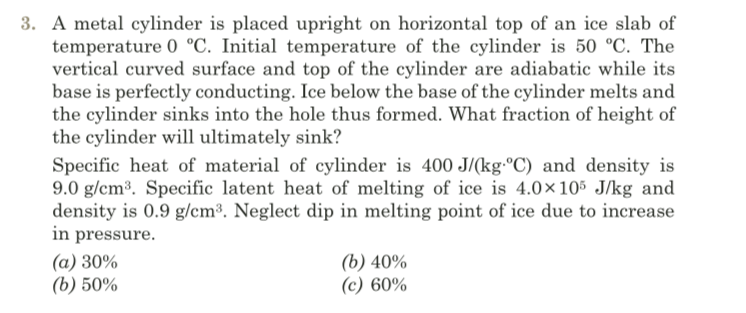3. A metal cylinder is placed upright on horizontal top of an ice slab of temperature 0 °C. Initial temperature of the cylinder is 50 °C. The vertical curved surface and top of the cylinder are adiabatic while its base is perfectly conducting. Ice below the base of the cylinder melts and the cylinder sinks into the hole thus formed. What fraction of height of the cylinder will ultimately sink? Specific heat of material of cylinder is 400 J/(kg°C) and density is 9.0 g/cm³. Specific latent heat of melting of ice is 4.0×105 J/kg and density is 0.9 g/cm³. Neglect dip in melting point of ice due to increase in pressure. (а) 30% (b) 50% (b) 40% (c) 60%
3. A metal cylinder is placed upright on horizontal top of an ice slab of temperature 0 °C. Initial temperature of the cylinder is 50 °C. The vertical curved surface and top of the cylinder are adiabatic while its base is perfectly conducting. Ice below the base of the cylinder melts and the cylinder sinks into the hole thus formed. What fraction of height of the cylinder will ultimately sink? Specific heat of material of cylinder is 400 J/(kg°C) and density is 9.0 g/cm³. Specific latent heat of melting of ice is 4.0×105 J/kg and density is 0.9 g/cm³. Neglect dip in melting point of ice due to increase in pressure. (а) 30% (b) 50% (b) 40% (c) 60%
Introduction to Chemical Engineering Thermodynamics
8th Edition
ISBN:9781259696527
Author:J.M. Smith Termodinamica en ingenieria quimica, Hendrick C Van Ness, Michael Abbott, Mark Swihart
Publisher:J.M. Smith Termodinamica en ingenieria quimica, Hendrick C Van Ness, Michael Abbott, Mark Swihart
Chapter1: Introduction
Section: Chapter Questions
Problem 1.1P
Related questions
Question
Pls find the Question attached

Transcribed Image Text:3. A metal cylinder is placed upright on horizontal top of an ice slab of
temperature 0 °C. Initial temperature of the cylinder is 50 °C. The
vertical curved surface and top of the cylinder are adiabatic while its
base is perfectly conducting. Ice below the base of the cylinder melts and
the cylinder sinks into the hole thus formed. What fraction of height of
the cylinder will ultimately sink?
Specific heat of material of cylinder is 400 J/(kg-°C) and density is
9.0 g/cm³. Specific latent heat of melting of ice is 4.0×105 J/kg and
density is 0.9 g/cm³. Neglect dip in melting point of ice due to increase
in pressure.
(a) 30%
(b) 50%
(b) 40%
(c) 60%
Expert Solution
This question has been solved!
Explore an expertly crafted, step-by-step solution for a thorough understanding of key concepts.
Step by step
Solved in 6 steps

Knowledge Booster
Learn more about
Need a deep-dive on the concept behind this application? Look no further. Learn more about this topic, chemical-engineering and related others by exploring similar questions and additional content below.Recommended textbooks for you

Introduction to Chemical Engineering Thermodynami…
Chemical Engineering
ISBN:
9781259696527
Author:
J.M. Smith Termodinamica en ingenieria quimica, Hendrick C Van Ness, Michael Abbott, Mark Swihart
Publisher:
McGraw-Hill Education

Elementary Principles of Chemical Processes, Bind…
Chemical Engineering
ISBN:
9781118431221
Author:
Richard M. Felder, Ronald W. Rousseau, Lisa G. Bullard
Publisher:
WILEY

Elements of Chemical Reaction Engineering (5th Ed…
Chemical Engineering
ISBN:
9780133887518
Author:
H. Scott Fogler
Publisher:
Prentice Hall

Introduction to Chemical Engineering Thermodynami…
Chemical Engineering
ISBN:
9781259696527
Author:
J.M. Smith Termodinamica en ingenieria quimica, Hendrick C Van Ness, Michael Abbott, Mark Swihart
Publisher:
McGraw-Hill Education

Elementary Principles of Chemical Processes, Bind…
Chemical Engineering
ISBN:
9781118431221
Author:
Richard M. Felder, Ronald W. Rousseau, Lisa G. Bullard
Publisher:
WILEY

Elements of Chemical Reaction Engineering (5th Ed…
Chemical Engineering
ISBN:
9780133887518
Author:
H. Scott Fogler
Publisher:
Prentice Hall


Industrial Plastics: Theory and Applications
Chemical Engineering
ISBN:
9781285061238
Author:
Lokensgard, Erik
Publisher:
Delmar Cengage Learning

Unit Operations of Chemical Engineering
Chemical Engineering
ISBN:
9780072848236
Author:
Warren McCabe, Julian C. Smith, Peter Harriott
Publisher:
McGraw-Hill Companies, The